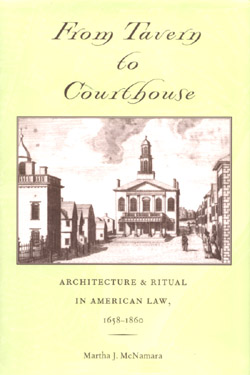Legal History and Material Culture of the Law

This is an important book that will be of great interest to architectural historians, legal historians, and historians of the professions. It is also a major contribution to the study of the history of the material culture of law and law practice in the United States, a subject that has attracted too little attention from legal historians.

Professor McNamara provides a detailed analysis of the development of professional buildings, especially courthouses, in Massachusetts, primarily from the late seventeenth century until the early nineteenth century. In so doing she illuminates a chapter in the history of the professionalization of lawyers and of architects in the U.S. during this period. Her text is especially rich in her discussions of the ways in which changing architectural styles were able to play into the growing rituals of the law and the courts, rituals that themselves were adopted in order to move lawyers from the general body of the mercantile class into the category of professionals. As Perry Miller pointed out in his masterly The Life of the Mind in America (New York, 1965), it was precisely during this period that American lawyers made a concerted effort to define themselves as a learned profession much as the clergy had done earlier. Professor McNamara adds to and confirms Miller’s thesis by bringing the evidence of courthouse architecture to the attention of historians.
Although American legal history has become something of a growth industry during the past several decades, little work has been done on the material context within which lawyers and judges operated during the antebellum period. We know a great deal about the literature of the law, but a good bit less about how lawyers obtained the books that transmitted this literature. We know a fair amount about theories of trial procedure, but scarcely anything about the courtrooms in which lawyers and judges practiced. Indeed, we know very little about the lives of lawyers and judges themselves, other than of those who achieved contemporary fame like Marshall, Story, or Kent and, thereby, merited a biography. In this short book Professor McNamara demonstrates how much we lose by not knowing these things and how much we can gain by learning about them. An example drawn from this work illustrates this point.
In 1786 Isaac Coombs, a Native American, was tried at Ipswich for the murder of his wife. Coombs was found guilty by the jury. Although we cannot now reconstruct many of the details of this trial, one thing stands out as Professor McNamara so ably shows. Coombs’s defense lawyer challenged the jury verdict on the grounds that the jury “did separate and go at large without being attended by the proper officer . . . and did converse with diverse persons concerning the verdict” (55)
In and of itself this is an interesting bit of information. But put into the context of the architecture of the Ipswich Townhouse, where trials were held, it is very revealing. As Professor McNamara notes, the Ipswich courthouse, like its contemporaries, did not have a separate room in which juries could deliberate after hearing the evidence in a trial. Instead, the jury gathered in a nearby tavern and walked freely among the other patrons while doing so. Although Coombs’s appeal was denied and he was hanged, the fact that his lawyer could object to the nonsequestration of the jury during deliberations points out that by this period lawyers were beginning to see the prejudicial consequences of such lack of privacy. Indeed, McNamara shows that soon after Coombs’s trial, new courthouses, designed by judges and lawyers, included separate spaces for jury deliberations. By 1805 the Town of Newburyport built a new courthouse with three rooms in the basement for jury deliberations.
It is through examples such as these that Professor McNamara educates her readers on the important interplay between the practice of law and the design of legal spaces in the antebellum period. The book is filled with such rich insights and is a delight to read.
If one were forced to come up with criticisms of this book, they would be two. First, although the title indicates that the book is both national in scope and that the period it covers extends to 1860, in fact the book is almost exclusively focused on the Massachusetts experience with legal architecture. Second, there is virtually no consideration of the legal architecture even of Massachusetts past the first quarter of the nineteenth century. But these are both quibbles. Indeed, the book gains from its narrow geographic and temporal focus, for by being so focused the author is able to examine her subject in great detail. On the other hand, one may well hope that Professor McNamara extends her researches both outside Massachusetts and further in time. By so doing she will both fill gaps in our knowledge that still exist and also extend her work to its logical ends. Professor McNamara’s opinions on the architecture of frontier courthouses and other legal spaces would be especially welcome.
A second item I would put on my wish list of things for Professor McNamara to consider is the development of lawyers’ offices and their relationship to the professionalization of the bar. Professor McNamara touches on office architecture several times, especially when she speaks of Melville’s “Bartleby,” but there is much more that she could do. We have drawings and, after the invention of photography, photographs of lawyers’ offices. We may only hope that Professor McNamara will turn her considerable analytic and historical skills to a consideration of these.
In sum, Professor McNamara’s work is one that no historian of the law or architecture can ignore. It is well written, well reasoned, and breaks important new ground. I, for one, shall be very glad when she publishes her next work.
This article originally appeared in issue 5.3 (April, 2005).
Michael Hoeflich is the Kane Professor of Law and Courtesy Professor of History at the University of Kansas.